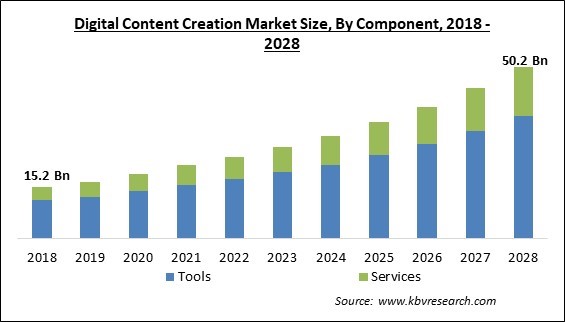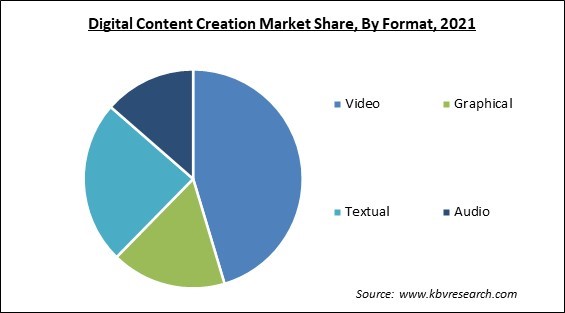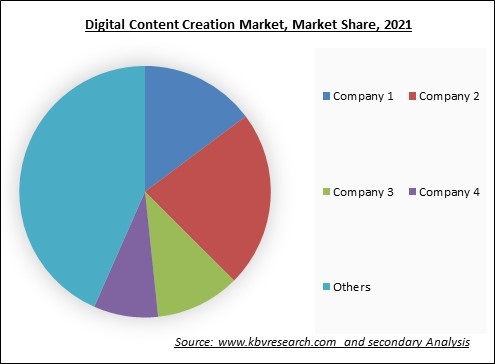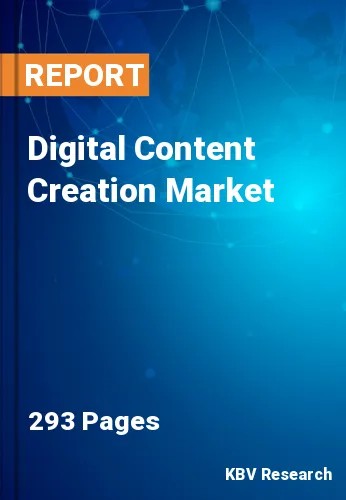The Global Digital Content Creation Market size is expected to reach $50.2 billion by 2028, rising at a market growth of 13.2% CAGR during the forecast period.
Digital content is a file or information stored or sent digitally. Digital content production is gathering knowledge and creating ideas from media and surroundings. Low operational expenses, a high return on investment (ROI), simplicity of monitoring and modification, brand extension, goal targeting, segmentation, and a business-focused approach are just a few benefits of developing digital content. Text, audio, video, graphics, and photographs are just a few available delivery methods.

Generating digital material involves producing it in various content formats, including text, graphics, audio, and video, and distributing or advertising it on internet platforms. The major competitors in this market provide their services via software and apps that may be used on-premises or in the cloud. The need for the digital content creation market is being fueled by elements including the expansion of AI use, investments in IT, and the rising use of cloud computing.
For example, in 2021, 200 zettabytes of data were stored worldwide in the same year, according to Cybersecurity Ventures, or 50% of all data, as opposed to 2015, when just 25% of all data was saved on the cloud. When developing and choosing the right content to satisfy the needs of organizations, digital content development tools, and services are crucial. Targeting the right audience is made more accessible by creating relevant material, such as white papers, e-newsletters, blog posts, case studies, etc.
A vital tool for B2B communication, digital content production has become more prevalent due to rising online traffic and the proliferation of internet services. Businesses are embracing digital content development tools and services to apply digital marketing strategies to exploit increasing internet traffic. As a result, the market for digital content creation has grown significantly over the last several years.
Many businesses in the digital content production sector have lost billions of dollars due to postponed trade shows and canceled events. B2B enterprises are now resorting to online marketing to reframe their marketing messaging due to rising knowledge of the benefits of digital marketing and the fact that many strategists are now spending most of their time in home isolation due to the COVID-19 pandemic. The popularity of COVID-19 has inspired businesses to improve their digital presence for long-term success. The development of digital content has helped firms stay on top of their digital strategies even while the bulk of activities are handled in solitude. This is projected to propel the worldwide market for producing digital content in the following years.
A significant factor anticipated to fuel the expansion of the market for digital content creation during the projected period is the rise in demand for digitalized material from different business sectors. In addition, the market expansion is also fueled by the expanding demand from different company sectors for sophisticated digital content development tools to draw in a sizable customer base via improved marketing techniques. For instance, social media companies like Facebook, Twitter, and Slack, which have included GIFs in their platforms for marketing, often utilize the GIPHY application.
The market for digital content creation for the hotel industry is changing due to personalization marketing, voice search, and AI. As a result, it is expected that the hotel sector would command the third-highest income in the market for digital content creation and is embracing digital technology quickly. Thus, marketers in the hotel sector are concentrating on email marketing to create leads to increase exposure among their target demographic. In addition, with targeted emails, stakeholders may get to know their clients better and encourage repeat business. This supports the growth of the regional market.

In order to avoid legal disputes over content rights, content owners must also establish harmonious relationships with theatre goers and broadcasters. Also, there is fierce rivalry among suppliers of digital content services as they fight for a largest market share. The fragmented market has major brands and specialized businesses competing on cost, features, and functionality. Consequently, it is anticipated that throughout the projection period, content availability restrictions will impede market development.
Based on component, the digital content creation market is segmented into tools, and services. In 2021, the tool segment held the highest revenue share in the digital content creation market. This is due to the rise in smartphone use of technologies for digital advertising. Also, many customers use search engines such as Google on their cellphones to find new goods and services. Also, this makes it vital for marketers to utilize SEO technologies.

The leading players in the market are competing with diverse innovative offerings to remain competitive in the market. The illustration shows the percentage of revenue shared by some of the leading companies in the market. The leading players of the market are adopting various strategies in order to cater demand coming from the different industries. The key developmental strategies in the market are Acquisitions, and Partnerships & Collaborations.
By format, the digital content creation market is fragmented into textual, graphical, video and audio. In 2021, the graphical segment covered a considerable revenue share in the digital content creation market. This is due to the rise in the use of infographic material by many businesses to create engaging digital content, like graphs, charts, and dashboards. Graphic design uses images to convey concepts or messages. Every sector may use it to provide complex information in a comprehensible manner.
Based on the deployment, the digital content creation market is segmented into on-premise and cloud. In 2021, the cloud segment had the largest revenue share in the market for digital content creation market. This is because everyone may now engage in the digital economy due to the globalization of cloud computing for businesses and people in the market for digital content creation. In addition, the burdens of the media and entertainment business may now be handled by the cloud as more collaborative storytelling becomes simpler for artists. Thus, the cloud segment's revenue will rise throughout the projection period.
Based on Organization size, the digital content creation market is bifurcated into large size enterprises, small & medium-sized enterprises. In 2021, the small & medium sized enterprise segment recorded a remarkable revenue share in the digital content creation market. Due to significant market participants' many steps to assist SMEs, this category is anticipated to provide excellent returns. To increase their market reach, SMEs are increasingly choosing digital marketing tactics. This is projected to help the market for digital content creation in this area develop.
By Vertical, the digital content creation market is categorized into retail & e-commerce, automotive, healthcare & pharmaceutical, media & entertainment, travel & tourism and others. The retail & e-commerce segment registered the largest revenue share in the digital content creation market in 2021. This results from actions made by significant market participants like Walmart Inc. and Amazon.com, Inc. Sales of online purchases are rapidly increasing. As a result, companies are making substantial investments to boost their online visibility to convert leads into qualifying purchases. With constant communication between buyers and sellers, the internet has emerged as the busiest marketplace.
| Report Attribute | Details |
|---|---|
| Market size value in 2021 | USD 21.4 Billion |
| Market size forecast in 2028 | USD 50.2 Billion |
| Base Year | 2021 |
| Historical Period | 2018 to 2020 |
| Forecast Period | 2022 to 2028 |
| Revenue Growth Rate | CAGR of 13.2% from 2022 to 2028 |
| Number of Pages | 293 |
| Number of Table | 540 |
| Report coverage | Market Trends, Revenue Estimation and Forecast, Segmentation Analysis, Regional and Country Breakdown, Market Share Analysis, Companies Strategic Developments, Company Profiling |
| Segments covered | Component, Format, Deployment, Organization Size, Vertical, Region |
| Country scope | US, Canada, Mexico, Germany, UK, France, Russia, Spain, Italy, China, Japan, India, South Korea, Singapore, Malaysia, Brazil, Argentina, UAE, Saudi Arabia, South Africa, Nigeria |
| Growth Drivers |
|
| Restraints |
|
Region wise, the digital content creation market is analyzed across North America, Europe, Asia Pacific and LAMEA. North America region led the digital content creation market by generating the highest revenue share in 2021. This results from the widespread usage of digital content production tools and services, their high acceptance and penetration, and their extensive applicability throughout the region's many end-user sectors. The expansion of the market in the United States is further fueled by the existence of top tool developers nationwide.
Free Valuable Insights: Global Digital Content Creation Market size to reach USD 50.2 Billion by 2028
The market research report covers the analysis of key stake holders of the market. Key companies profiled in the report include Adobe, Inc., Corel Corporation (KKR & Co., Inc.), MarketMuse, Inc., Quark Software, Inc. (Parallax capital partners, LLC), Integra Software Services Pvt. Ltd., Acrolinx GmbH, Google LLC (Alphabet, Inc.), PicsArt, Inc., Microsoft Corporation, and Canva Pty Ltd.
By Component
By Format
By Deployment
By Organization Size
By Vertical
By Geography
The global Digital Content Creation Market size is expected to reach $50.2 billion by 2028.
AI and email marketing transform the hospitality sector, encouraging repeat business are driving the market in coming years, however, A significant problem is the availability of content restrictions restraints the growth of the market.
Adobe, Inc., Corel Corporation (KKR & Co., Inc.), MarketMuse, Inc., Quark Software, Inc. (Parallax capital partners, LLC), Integra Software Services Pvt. Ltd., Acrolinx GmbH, Google LLC (Alphabet, Inc.), PicsArt, Inc., Microsoft Corporation, and Canva Pty Ltd.
The Video segment acquired maximum revenue share in the Global Digital Content Creation Market by Format in 2021 thereby, achieving a market value of $22.2 billion by 2028.
The Large Enterprises segment is leading the Global Digital Content Creation Market by Organization Size in 2021 thereby, achieving a market value of $30.9 billion by 2028.
The North America market dominated the Global Digital Content Creation Market by Region in 2021, and would continue to be a dominant market till 2028; thereby, achieving a market value of $17.4 billion by 2028.
Our team of dedicated experts can provide you with attractive expansion opportunities for your business.

